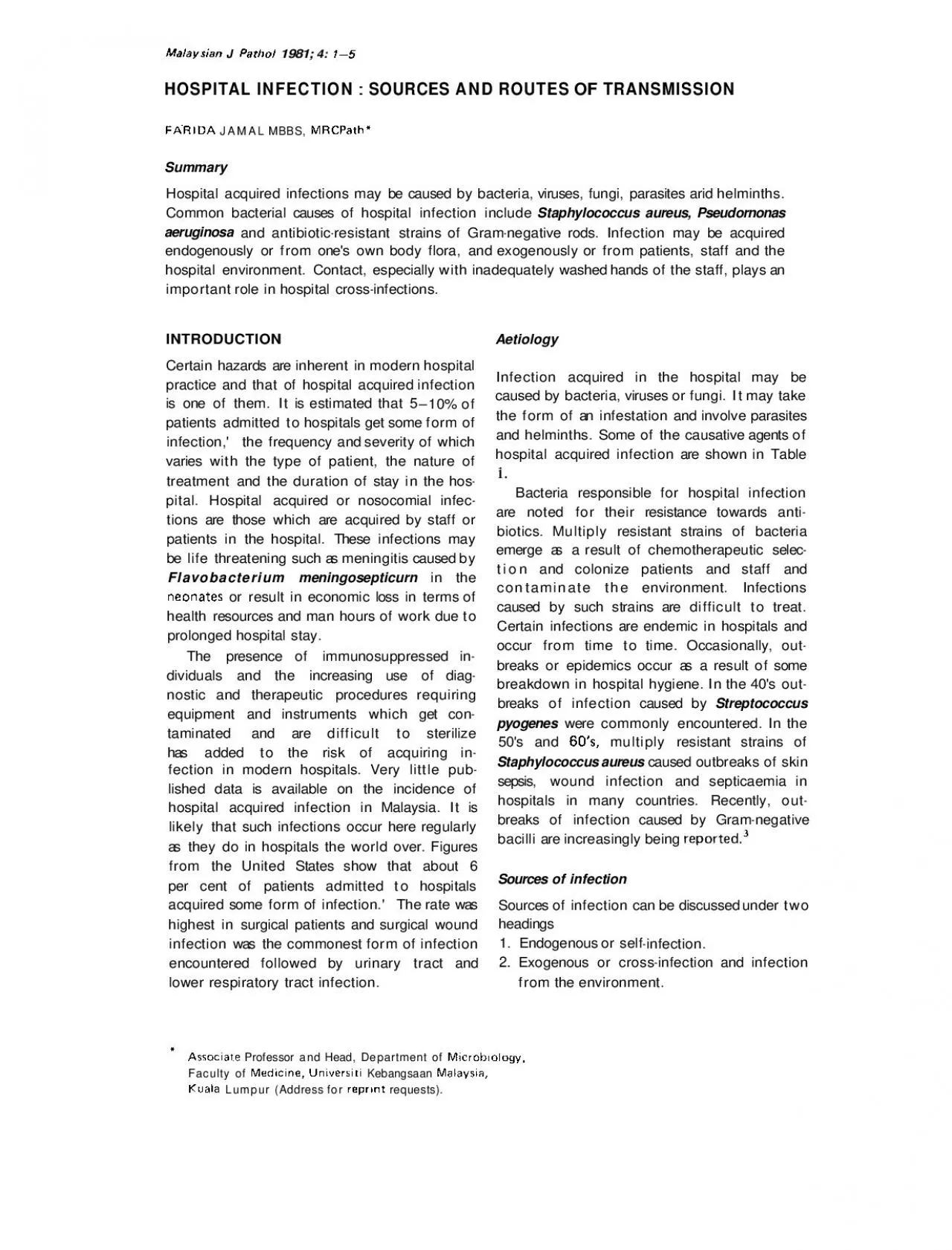

Malay sian J Path01 1981 4 15 FARIDA JAMAL MBBS MRCPath Hospital acquired Common bacterial flora and exogenously patients staff hospital environment Contact of the staff hospital cr ID: 961595
Download Pdf The PPT/PDF document "HOSPITAL INFECTION SOURCES AND ROUTES O..." is the property of its rightful owner. Permission is granted to download and print the materials on this web site for personal, non-commercial use only, and to display it on your personal computer provided you do not modify the materials and that you retain all copyright notices contained in the materials. By downloading content from our website, you accept the terms of this agreement.
Malay sian J Path01 1981; 4: 1-5 HOSPITAL INFECTION : SOURCES AND ROUTES OF TRANSMISSION FARIDA JAMAL MBBS, MRCPath' Hospital acquired Common bacterial flora, and exogenously patients, staff hospital environment. Contact, of the staff, hospital crossmodern hospital of hospital acquired the hospital by bacteria, or fungi. may take the frequency of which type of patient, the nature the hosHospital acquired the hospital. neonates resources and man hours prolonged hospital stay. dividuals and and therapeutic procedures the
risk hospitals. Very lished data available on the incidence hospital acquired infection in likely that do in hospitals the over. Figures the United The rate and surgical the commonest respiratory tract Bacteria responsible colonize patients con taminate environment. Infections time. Occasionally, epidemics occur of infection 601s, resistant strains of skin wound infection many countries. Recently, by Gramincreasingly being rep~rted.~ of infection or selfExogenous or * Assoclate Professor and Head, Department of M~crob~olo
yy, Faculty of Medlclne, Unlvers~tl Kebangsaan Malaysia, Kuala Lumpur (Address for reprlnt requests). TYPES OF INFECTION: PRINCIPAL ROUTES OF THE ENVIRONMENT 1 Source Skin Nose Intestine Female genital tract Principal pathogens Staph ylococcus aureus Staph ylococcus aureus tract infection tract infection Urinary tract the environment Staph ylococcus aureus Staphylococcus aureus Gram-negative bacilli Staphylococcus aureus Staphylococcus aureus Staphylococcus aureus Other GramN o N o Route of situations
Yes Yes Yes Yes Y em Yes Yes Yes Yes Yes Yes Yes Yes Mala ysian J Path01 the air situations (Table Contaminated droplets may also direct contact the hospital staff factor in time contributes remained unclean. this route Klebsiella group, Pseudomonas may also normally sterile sterilized instruments. of hepatitis contaminated hypodermic risk areas higher incidence others. The variety of infectious effective preventive Lowbury EJL, Ayliffe GAJ, Geddes AM, Williams JD, comps. of hospital practical handbook. Chapman
Hall Ltd., Reinarz JA, Megna MJ, Noso- comial time for DN, Sanford l n f Strat- ton, Inc., 1979 : 219-40. 3. Lim VKE, Jamal F. Prevalence of genta- scientific meeting Malay- Pathologists, Kuala Lumpur, 1980. Lidwell Isolating patients HIGH INFECTION RISK AREAS THE HOSPITAL and Renal intravenous infusions. Lowered local Peritonea1 dialysis Use of kidney machines Poorly developed immune response - of infection tract infection Urinary tract negative septicaemia tract infection, peritonitis, hepatitis Skin infection,